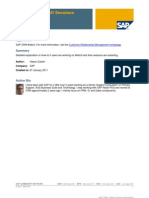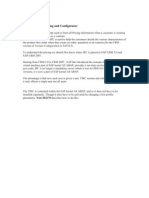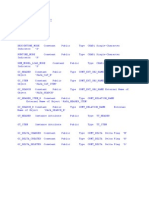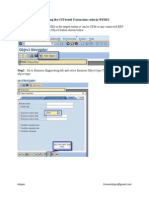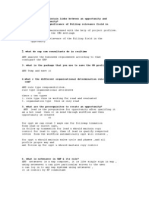ERMS
ERMS
Uploaded by
Veena NadipalliCopyright:
Available Formats
ERMS
ERMS
Uploaded by
Veena NadipalliCopyright
Available Formats
Share this document
Did you find this document useful?
Is this content inappropriate?
Copyright:
Available Formats
ERMS
ERMS
Uploaded by
Veena NadipalliCopyright:
Available Formats
Service Manager Profile & Rule Modeler
CONFIGURING THE ERMS SERVICE MANAGER PROFILE,RULE MODELER & CREATION OF THE SERVICE CLASSES
Table of Contents
Introduction..............................................................................................................................2 Prerequisite...............................................................................................................................3 Step By Step Procedure ..........................................................................................................4 Conclusion ............................................................................................................................19
Service Manager Profile & Rule Modeler
Introduction
The ERMS Service Manager profile manages the order of executing the directly and indirectly called services. The Service Manager Profile calls an Rule Policy which executes the rules defined in it. The Rule Policy can be defined in the Rule modeler. Rule modeler is the application which is used for creating, editing the rule policies that are used to handle and evaluate the inbound emails. Rule modeler uses the objects defined in the repository such as attributes, operators, and actions to create rules. Actions are components that gets triggered if conditions were met. A rule can have any number of actions. While defining these actions, we assign specific Service to it, which triggers the Service Class to execute. The ERMS Service Classes when created should be include with the Interface IF_CRM_ERMS_SERVICE. The method EXECUTE of this interface is the only method which gets executed in this Class. If we create custom methods in this class, a call to those methods should be made in the EXECUTE method, then only they will get executed. Generally, keeping a session breakpoint or external breakpoint doesnot get trigerred eventhough these Service Classes were executed. Inorder to debug the Service Classes which are executed in Service Manager Profile, we can use the Transaction CRM_ERMS_LOGGING. We have to keep a session breakpoint in the Service class and then go to transaction SWI1(Selection Report for Workitems) and copy the background task workitem ID of the email for which the Service Class has been trigerred. Now, Goto transaction CRM_ERMS_LOGGING and enter the workitem id and Service Manager Profile and execute it.
Service Manager Profile & Rule Modeler
Prerequisite
The user should have necessary customizing authorizations to maintain the Service Manager Profile and should have a developer authorizations to create the Service Classes and make sure that all the ERMS configuration was complete.
Service Manager Profile & Rule Modeler
Step By Step Procedure
CREATION OF SERVICE CLASS: Goto transaction SE24-Class Builder
Enter
the Service Class name in the Object Type field & Click on Create.
The Service Class is created successfully after providing the required details.
Goto Interfaces Tab.
Service Manager Profile & Rule Modeler
Enter Interface as IF_CRM_ERMS_SERVICE.
Now, Goto Methods Tab.The EXECUTE method of the interface IF_CRM_ERMS_SERVICE gets populated.
Service Manager Profile & Rule Modeler
Save & Activate the Service Class.
Inside the IF_CRM_ERMS_SERVICE~EXECUTE method, we can implement our code based on the requirement.In this method we can access the factbase,email content,actions,workitem container, etc. that are defined in the Service Manager. DEFINING THE SERVICES: For Defining the Services, Follow the path SAP Implementation Guide--- Customer Relationship Management--- E-Mail Response Management System---- Service Manager--Define Services Click on Execute button
For creating the new Service Click on New Entries button.
Service Manager Profile & Rule Modeler
In the New Entries:Details of Added Entries screen a. Enter the Service ID(starting with Y or Z). b. Enter the Relevant Description. c. Enter the Service Type based on requirement.Service type can be either, Fact Gathering Action Handling Rule Invocation Utility d. Enter the Service class name.
Click on Save button.The Service gets created based on the details provided. DEFINING THE ACTIONS IN REPOSITORY:
Service Manager Profile & Rule Modeler
Follow the path SAP Implementation Guide--- Customer Relationship Management--- E-Mail Response Management System---- Service Manager--Define Repository
Click on the Execute button.
Select 'ERMS' in the Contexts, & Double click on the Actions node.
Service Manager Profile & Rule Modeler
The Actions screen, displays the list of actions defined in the system.
Service Manager Profile & Rule Modeler
Click on New Entries button.Enter the Action ID Description Check the 'Show Action' checkbox Action Service ID Conflict Type. If we check the Show Action check box, then only the Action will be shown in the Rule Modeler.The Action description defined here, is the one which displayed in the Action drop downlist in the Rule Modeler.
Click on Save button.The Action is created successfully under the ERMS Context. Now, the newly created Action can be used directly in the Service Manager Profile under the 'Directly called Services' or else we can assign to a rule in the Rule Modeler and then use the Rule Execution(RE_RULE_EXEC) Service.
CREATING A RULE POLICY USING RULE MODELER:
10
Service Manager Profile & Rule Modeler
Now, Inorder to create a Rule Policy we have to login to WEB UI with the Manager's Portal & Click on Create Rule Policy workcentre link
Select the Context as 'E-Mail Response Management System' & Enter the Rule Policy.Press on Ok.
In the next screen, Select the Draft Rules node under the Policy block.
11
Service Manager Profile & Rule Modeler
Inorder to create a Rule Folder Click on New button.
After the Rule Folder is created.Now, we are ready to create a Rule.Select the Rule Folder & Click on New button. Enter the Rule name & Description in the Rule Details Block Add entries for Conditions, based on the Attributes & Operator values.
12
Service Manager Profile & Rule Modeler
Add entries for Actions which needs to be executed once the condition defined above were evaluated to true.
DEFINING SERVICE MANAGER PROFILE: For Defining the Service Manager Profile,
13
Service Manager Profile & Rule Modeler
Follow the path SAP Implementation Guide--- Customer Relationship Management--- E-Mail Response Management System---- Service Manager--Define Service Manager Profile
Click on Execute Button.
Click on New Entries.
14
Service Manager Profile & Rule Modeler
Enter the Service Manager Profile Name & the respective Description.
Save it & Double Click on 'Directly Called Services' Node.
Once the Service Manager Profile is created, it has some Directly called Services which needs to be maintained mandatorily.These include Services, SVC_PARAMS - Utility Service to store parameters
15
Service Manager Profile & Rule Modeler
FG_WEBFORM - Fact Gathering Service for Webforms UT_WORKITEMTEXT - Utility Service to store Work Item Text details RE_RULE_EXEC - Rule Invocation Service for Rule Execution AH_DEF_ROUTING - Action Handling Class for Default Routing UT_ERMS_REPLICAT - Utility Service for Replication of Rules and Categories
In order to maintain these Services, Click on New Entries. Enter the Invocation Order number & the Service ID.Click on Save. The Services are invoked in the order in which they are maintained in the Service Manager Profile.So, one should be careful while defining the Invocation Order.
Select the Service 'RE_RULE_EXEC' & Double Click on the 'Properties' folder.
Click on New Entries & Enter the Property ID as 'CONTEXT' & Property Value as 'ERMS'.For defining the properties to a service, the initial property which needs to be defined is CONTEXT.
16
Service Manager Profile & Rule Modeler
Save it & again Click on New Entries to add the Rule Policy. Now, Enter the Property ID as POLICY & the Property Value as Y_TESTPOLICY(Name of Rule Policy).
ASSIGNING THE SERVICE MANAGER PROFILE:
17
Service Manager Profile & Rule Modeler
The defined Service Manager Profile should be assigned to the specific email id's to which the actions we defined were supposed to be trigerred. Follow the path SAP Implementation Guide--- Customer Relationship Management--- E-Mail Response Management System---- Service Manager--Assign Service Manager Profiles.
Click on New Entries.
Add the Email Address in the Address/Number & Assign the Service Manager Profile. Save it.
18
Service Manager Profile & Rule Modeler
After maintaining all these configurations, whenever a mail is being sent to the 'software.support.repliesri0@iqa-mailbox.intel.com' the Service Manager Profile Y_TESTMGRPRFL gets triggered.Which inturn triggers the rule policy Y_TESTPOLICY and it executes the Action Y_TEST_ACTION.This action calls the Service Y_AH_SERVICE and Service Class YCL_CRM_SERVICE_CLASS_AH associated with it gets executed.
Conclusion
This covers the steps that need to be followed for configuring the ERMS Service Manager Profile, Rule Modeler and Creation of Service Classes. For further information, refer www.help.sap.com
19
You might also like
- Virtual Carding Handbook 2.0 - 2020Document32 pagesVirtual Carding Handbook 2.0 - 2020Kader Milano67% (6)
- How To Setup - Business Process Model Connector For SAP Signavio Solutions - 202305Document52 pagesHow To Setup - Business Process Model Connector For SAP Signavio Solutions - 202305pravalikakaranNo ratings yet
- Learner Assessor BSBWHS521Document58 pagesLearner Assessor BSBWHS521Anzel Anzel0% (1)
- ErmsDocument49 pagesErmsvinodNo ratings yet
- E-Mail Response Management System (ERMS)Document12 pagesE-Mail Response Management System (ERMS)vinodNo ratings yet
- Table View in CRMDocument18 pagesTable View in CRMChiranjeevi MeesaNo ratings yet
- What Is Client Specific & Cross Client DataDocument10 pagesWhat Is Client Specific & Cross Client DataPILLINAGARAJU100% (1)
- Transaction Launcher. How To Create Transaction Launcher in SAP CRMDocument4 pagesTransaction Launcher. How To Create Transaction Launcher in SAP CRMSurya DamarlaNo ratings yet
- WebservieceDocument8 pagesWebservieceShaik FayazuddinNo ratings yet
- Changing The Sap Logo in CRM UiDocument2 pagesChanging The Sap Logo in CRM Uiirexen2012No ratings yet
- Upload A CSV Excel File or Text File in SAP CRM WebUIDocument13 pagesUpload A CSV Excel File or Text File in SAP CRM WebUIMohinder SureshNo ratings yet
- Replicating Data From EC To ERP HCM Config Guide 2H23Document32 pagesReplicating Data From EC To ERP HCM Config Guide 2H23nicolas.speziaNo ratings yet
- SAP CRM - WebUI Sessions RestartingDocument7 pagesSAP CRM - WebUI Sessions RestartingRajagopalan MuthukrishnanNo ratings yet
- Implementing PTP Time Data ReplicationDocument150 pagesImplementing PTP Time Data Replicationnicolas.speziaNo ratings yet
- EEWBDocument17 pagesEEWBManish Kumar100% (1)
- How-To Guide - A Quick Guide To B2B XCM ConfigurationDocument45 pagesHow-To Guide - A Quick Guide To B2B XCM Configurationrobi_kren0No ratings yet
- ADS Configuration in Netweaver 7.4Document11 pagesADS Configuration in Netweaver 7.4Devender RajuNo ratings yet
- CRM Bdoc InfoDocument6 pagesCRM Bdoc InfoNani VolsNo ratings yet
- Registry Service Provider SRMREGEDIT PDFDocument25 pagesRegistry Service Provider SRMREGEDIT PDFJoe MalemaNo ratings yet
- Tutorials - Day 1Document40 pagesTutorials - Day 1hplee35No ratings yet
- Dokumen - Tips - HR Renewal 20 fp2 Admin Guide PDFDocument31 pagesDokumen - Tips - HR Renewal 20 fp2 Admin Guide PDFYani LieNo ratings yet
- IPc ConfigurationDocument11 pagesIPc Configurationsapsd_n5No ratings yet
- Data Migration From SAP HCM To SFSF ECDocument92 pagesData Migration From SAP HCM To SFSF ECvivilaplataNo ratings yet
- Basic Customization For WorkflowDocument7 pagesBasic Customization For WorkflowGowthami VallepalliNo ratings yet
- Training MaterialDocument32 pagesTraining Materialrahulsaharan87No ratings yet
- FDMEE SAP BW Adapter Installation and Configuration Readme v1.0Document9 pagesFDMEE SAP BW Adapter Installation and Configuration Readme v1.0Sathya NarayananNo ratings yet
- Implementing A Service Provider PDFDocument25 pagesImplementing A Service Provider PDFJoe MalemaNo ratings yet
- SAP EHP Tech - Business Functions With Specific Enterprise ServicesDocument3 pagesSAP EHP Tech - Business Functions With Specific Enterprise ServicesUgur UyganNo ratings yet
- Understanding SAP CRM WebclientDocument6 pagesUnderstanding SAP CRM Webclienty_q_li9489No ratings yet
- RFC Destination - SAP SRMDocument9 pagesRFC Destination - SAP SRMNithya NatarajanNo ratings yet
- HCM Process and FormsDocument9 pagesHCM Process and FormsVenugopal PNo ratings yet
- SAP SuccessFactors Cloud HXM - EC - TaskBased Training Program by MiNdLiNkS - 2022NoVDocument5 pagesSAP SuccessFactors Cloud HXM - EC - TaskBased Training Program by MiNdLiNkS - 2022NoVPrabha BravoNo ratings yet
- B2B Integration Using Sap Netweaver Pi: Sam Raju, Claus WallacherDocument54 pagesB2B Integration Using Sap Netweaver Pi: Sam Raju, Claus Wallacherroughnext_scribdNo ratings yet
- Sappress Netweaver Process Integration PDFDocument51 pagesSappress Netweaver Process Integration PDFSuresh AmirisettyNo ratings yet
- Genil Class Web UI CodeDocument31 pagesGenil Class Web UI CodeBrett GarnerNo ratings yet
- Cash Desk SAP PDFDocument15 pagesCash Desk SAP PDFsandeep swamyNo ratings yet
- SAP CRM MethodsDocument7 pagesSAP CRM Methodskenguva_tirupati100% (1)
- SAP CRM Transaction LauncherDocument19 pagesSAP CRM Transaction LaunchermanojNo ratings yet
- Transaction LauncherDocument25 pagesTransaction LauncherChand ShaikNo ratings yet
- HR Master Record (Mini-Master) /automatic Maintenance of Vendor Master RecordsDocument9 pagesHR Master Record (Mini-Master) /automatic Maintenance of Vendor Master Recordsmari_scripcaruNo ratings yet
- Web Services With Application Server Abap: AbstractDocument6 pagesWeb Services With Application Server Abap: Abstractsl4ckwar3No ratings yet
- EC IntegrationDocument2 pagesEC IntegrationEngr Mehboob0% (1)
- Qatar WPS User ManualDocument1 pageQatar WPS User Manualdilrajs8No ratings yet
- Manual SmartformsDocument40 pagesManual SmartformsRosa María Islas MontielNo ratings yet
- Integration Documentation: Ecc - Hci - C4CDocument7 pagesIntegration Documentation: Ecc - Hci - C4CRobbin PintoNo ratings yet
- Sap La HR505 en 15 ExDocument110 pagesSap La HR505 en 15 ExSamson JosephNo ratings yet
- How To Launch The SAP CRM WEBUIDocument13 pagesHow To Launch The SAP CRM WEBUISidharth KumarNo ratings yet
- Algorithm Logic + Control PDFDocument13 pagesAlgorithm Logic + Control PDFtom-844468No ratings yet
- Enhancing Standard Programs Quickly and Easily Via Business Add-Ins (Badis)Document11 pagesEnhancing Standard Programs Quickly and Easily Via Business Add-Ins (Badis)Ricardo Perez SanchezNo ratings yet
- Adding A Column Owner To An Appraisal Template in Performance Management ModuleDocument10 pagesAdding A Column Owner To An Appraisal Template in Performance Management Moduletalwark18No ratings yet
- Improve Your Company's Revenues With SAP's Customer Down Payment ProcessDocument22 pagesImprove Your Company's Revenues With SAP's Customer Down Payment ProcessSarfraz Mohammed100% (1)
- Sap CRM Q&aDocument15 pagesSap CRM Q&aAsheesh SinghNo ratings yet
- DB2 9 System Administration for z/OS: Certification Study Guide: Exam 737From EverandDB2 9 System Administration for z/OS: Certification Study Guide: Exam 737Rating: 3 out of 5 stars3/5 (2)
- The Architecture of SAP ERP: Understand how successful software worksFrom EverandThe Architecture of SAP ERP: Understand how successful software worksNo ratings yet
- (Plc4me - Com) PanelBuilder600 ManualDocument376 pages(Plc4me - Com) PanelBuilder600 ManualMuhammad Hamza ZiaNo ratings yet
- Pengembangan Sistem Informasi Agribisnis 30287535Document13 pagesPengembangan Sistem Informasi Agribisnis 30287535M Akbar NashiruddinNo ratings yet
- Ai in Supply ChainDocument8 pagesAi in Supply Chainfarhan0% (1)
- EWARM MigratingFromCCS - ENUDocument2 pagesEWARM MigratingFromCCS - ENUPABLO IVAN TELLO SANDOVALNo ratings yet
- Security Economics Knowledge GuideDocument25 pagesSecurity Economics Knowledge GuideTeo Liang WeiNo ratings yet
- MSWord Excel With ABAPDocument18 pagesMSWord Excel With ABAPLuiz CarlosNo ratings yet
- Failure Analysis Report format-RKU-28.05.20Document3 pagesFailure Analysis Report format-RKU-28.05.20Asim GhoshNo ratings yet
- Parking Management SolutionDocument11 pagesParking Management Solutionmahendra bhamareNo ratings yet
- © 2010 Altimeter Group © 2011 Altimeter GroupDocument45 pages© 2010 Altimeter Group © 2011 Altimeter GroupMelanie NicholsNo ratings yet
- Ref - Calibration.Cage Levelling EN PDFDocument4 pagesRef - Calibration.Cage Levelling EN PDFKrum KashavarovNo ratings yet
- Data Structures & Algorithms: Ee-Yyy, Ds & As Dr. Mohammad Jaudet Jaudet@pieas - Edu.pkDocument10 pagesData Structures & Algorithms: Ee-Yyy, Ds & As Dr. Mohammad Jaudet Jaudet@pieas - Edu.pknaeema_58No ratings yet
- UTM061001Document56 pagesUTM061001AkoKhalediNo ratings yet
- Database Concepts: Getting Started With Microsoft SQL Server 2014 ExpressDocument19 pagesDatabase Concepts: Getting Started With Microsoft SQL Server 2014 ExpressLIK GONo ratings yet
- Airtel Information GuideDocument4 pagesAirtel Information GuideMonik MishraNo ratings yet
- 8051 InterruptsDocument20 pages8051 InterruptsAliNo ratings yet
- GPU Programming: Dr. Florian FerreiraDocument101 pagesGPU Programming: Dr. Florian FerreiraSlal OpzaNo ratings yet
- Learning Management System: IT Department, Virtual University of PakistanDocument28 pagesLearning Management System: IT Department, Virtual University of Pakistanmc060401390No ratings yet
- Mathematics of Cryptography: Part III: Primes and Related Congruence EquationsDocument50 pagesMathematics of Cryptography: Part III: Primes and Related Congruence Equationskassawmar ayuNo ratings yet
- Why ERP Implementation Fails: Check List 1: Diagnostic PhaseDocument8 pagesWhy ERP Implementation Fails: Check List 1: Diagnostic PhasehuseyinNo ratings yet
- My User ManualDocument21 pagesMy User Manualsumannamburi100% (3)
- 02.1-Project Management FrameworkDocument13 pages02.1-Project Management Frameworkhieupv227No ratings yet
- Capacity Management Process - HS2016Document23 pagesCapacity Management Process - HS2016fadilNo ratings yet
- E-Sys - Installation Instructions - v.16Document5 pagesE-Sys - Installation Instructions - v.16safetywireNo ratings yet
- TICTACTOEDocument26 pagesTICTACTOEsandyofficial.0305No ratings yet
- Lecture - Executive Information Systems and The Data WarehouseDocument25 pagesLecture - Executive Information Systems and The Data WarehousebondaigiaNo ratings yet
- Assignment02Semester2 Solutions PDFDocument5 pagesAssignment02Semester2 Solutions PDFSamkeh ZahNo ratings yet
- Flava Works vs. Myvidster, Marques Rondale Gunter, Salsa Indy, LLC. Appellant's Brief Filed by Appellants Marques Rondale Gunter and SalsaIndy LLCDocument80 pagesFlava Works vs. Myvidster, Marques Rondale Gunter, Salsa Indy, LLC. Appellant's Brief Filed by Appellants Marques Rondale Gunter and SalsaIndy LLCFlava WorksNo ratings yet
- Log Com - Roblox.client 1686918755Document328 pagesLog Com - Roblox.client 1686918755HarisNo ratings yet















